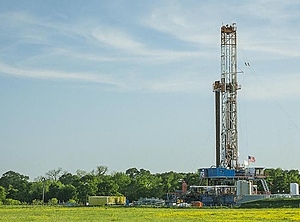INEOS
Billion-dollar deal for onshore Texas oil, gas / Foot in the door for future fracking?
 As upstream as you can get: Ineos acquires US oil and gas assets (Photo: Ineos) |
By plunking down USD 1.4 bn to acquire oil and gas assets in Texas from Chesapeake Energy (Oklahoma City, Oklahoma; www.chk.com), Ineos (London; www.ineos.com) seems to have finally kicked open the door to the US shale industry, at least partly fulfilling a long held dream of its founder, owner, and chairman Jim Ratcliffe.
Upon completion of a deal to be backdated to October 2022, subsidiary Ineos Energy, which incorporates the group’s oil and gas assets, will hold production and exploration leases across 172,000 acres (about 70,000 hectares) in the Eagle Ford Shale field of south Texas. The purchase also includes 2,300 wells producing an estimated net 36,000 bbl of oil equivalent per day.
Stretching from the Mexican border to northeast Texas, the Eagle Ford Formation has been the site of significant oil and gas development and production in recent years, Ineos noted, adding that the area could hold more than 10 bn bbl of oil and nearly 10 tn m³ of natural gas.
With the world “critically dependent” upon oil and gas as a transitional energy source until enough green energy is available, the UK-managed group said it expects to play an important part in this transition, ultimately focusing on hydrogen and carbon sequestration.
Upon completion of a deal to be backdated to October 2022, subsidiary Ineos Energy, which incorporates the group’s oil and gas assets, will hold production and exploration leases across 172,000 acres (about 70,000 hectares) in the Eagle Ford Shale field of south Texas. The purchase also includes 2,300 wells producing an estimated net 36,000 bbl of oil equivalent per day.
Stretching from the Mexican border to northeast Texas, the Eagle Ford Formation has been the site of significant oil and gas development and production in recent years, Ineos noted, adding that the area could hold more than 10 bn bbl of oil and nearly 10 tn m³ of natural gas.
With the world “critically dependent” upon oil and gas as a transitional energy source until enough green energy is available, the UK-managed group said it expects to play an important part in this transition, ultimately focusing on hydrogen and carbon sequestration.
Frack attack
Ratcliffe, however, a fierce proponent of fracking, has cast more than one sidelong glance across the Atlantic since losing a long-running battle to make the UK a centre for use of the technology, and he recently tried to bring the argument back to the fore. Some observers say his ultimate US plans could see more than one scenario for the gas assets.
While the current purchase does not seem to have extensive potential for fracking, owning the acreage would at least give Ineos a stake in the US market, which is gaining renewed importance in the wake of Russia’s invasion of Ukraine as gas prices soar.
Chesapeake is selling the Texas assets under pressure from activist investor Kimmeridge Energy Management. The private equity group has urged management to focus on natural gas deposits in the Marcellus gas field of Appalachia and the Haynesville basin of Louisiana and east Texas, with an eye to exporting.
Commenting on the US buy, Ineos Energy chairman Brian Gilvary, former CFO of BP, called it “a significant step in the company’s journey.” Over the past two decades, he said, “the US onshore oil and gas production has provided security of supply for the global market and competitive advantage for US industry.”
In Europe, Ineos Energy is currently focusing on exploration and production of both onshore and offshore oil and gas assets in the North Sea. In recent years, it has invested in low-carbon technologies, including carbon capture and storage (CCS) as well as hydrogen.
The London group is also part of a consortium of 11 companies supporting large-scale deployment of carbon capture and storage (CCS) technology in Houston, Texas, and is additionally engaged in projects to develop demand for hydrogen to replace existing carbon-based sources of energy, feedstocks, and fuel.
While the current purchase does not seem to have extensive potential for fracking, owning the acreage would at least give Ineos a stake in the US market, which is gaining renewed importance in the wake of Russia’s invasion of Ukraine as gas prices soar.
Chesapeake is selling the Texas assets under pressure from activist investor Kimmeridge Energy Management. The private equity group has urged management to focus on natural gas deposits in the Marcellus gas field of Appalachia and the Haynesville basin of Louisiana and east Texas, with an eye to exporting.
Commenting on the US buy, Ineos Energy chairman Brian Gilvary, former CFO of BP, called it “a significant step in the company’s journey.” Over the past two decades, he said, “the US onshore oil and gas production has provided security of supply for the global market and competitive advantage for US industry.”
In Europe, Ineos Energy is currently focusing on exploration and production of both onshore and offshore oil and gas assets in the North Sea. In recent years, it has invested in low-carbon technologies, including carbon capture and storage (CCS) as well as hydrogen.
The London group is also part of a consortium of 11 companies supporting large-scale deployment of carbon capture and storage (CCS) technology in Houston, Texas, and is additionally engaged in projects to develop demand for hydrogen to replace existing carbon-based sources of energy, feedstocks, and fuel.
28.02.2023 Plasteurope.com [252279-0]
Published on 28.02.2023
